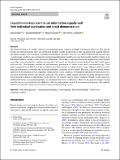Files in this item
Capuchin monkeys learn to use information equally well from individual exploration and social demonstration
Item metadata
| dc.contributor.author | Kean, Donna | |
| dc.contributor.author | Renner, Elizabeth | |
| dc.contributor.author | Atkinson, Mark | |
| dc.contributor.author | Caldwell, Christine A | |
| dc.date.accessioned | 2022-12-07T17:30:10Z | |
| dc.date.available | 2022-12-07T17:30:10Z | |
| dc.date.issued | 2022-09-05 | |
| dc.identifier | 281525571 | |
| dc.identifier | ebdeed6d-d2ae-4bad-8211-ec8bfc0cdbb0 | |
| dc.identifier | 36064832 | |
| dc.identifier | 85137415526 | |
| dc.identifier | 000849989600002 | |
| dc.identifier.citation | Kean , D , Renner , E , Atkinson , M & Caldwell , C A 2022 , ' Capuchin monkeys learn to use information equally well from individual exploration and social demonstration ' , Animal Cognition , vol. First Online . https://doi.org/10.1007/s10071-022-01654-0 | en |
| dc.identifier.issn | 1435-9448 | |
| dc.identifier.other | Jisc: 611541 | |
| dc.identifier.other | pii: 10.1007/s10071-022-01654-0 | |
| dc.identifier.uri | https://hdl.handle.net/10023/26556 | |
| dc.description | This project was funded by the European Research Council (ERC) under the European Union's Horizon 2020 research and innovation programme under grant agreement No. 648841 RATCHETCOG ERC-2014-CoG. DK was supported by a PhD studentship funded by the ERC and University of Stirling Department of Psychology. Edinburgh Zoo’s Living Links Research Facility is core supported by the Royal Zoological Society of Scotland (Registered charity number: SC004064) through funding generated by its visitors, members and supporters, and by the University of St Andrews (Registered charity number: SC013532) who core supports the maintenance and management costs of the research facility. | en |
| dc.description.abstract | The limited evidence of complex culture in non-human primates contrasts strikingly with human behaviour. This may be because non-human primates fail to use information acquired socially as effectively as they use information acquired individually. Here, monkeys were trained on a stimulus discrimination task with a win-stay, lose-shift (WSLS) reward structure. In a social learning condition, the experimenter performed an information trial by choosing between the available stimuli; in an individual condition, monkeys made this choice themselves. The monkeys' subsequent test trials displayed the same stimulus array. They were rewarded for repetition of rewarded ('win-stay') and avoidance of unrewarded ('lose-shift') information trial selections. Nine monkeys reached our pre-determined performance criterion on the initial two-stimulus stage. Their ability to generalise the WSLS strategy was then evaluated by transfer to a three-stimulus stage. Minimal differences were found in information use between the social and individual conditions on two-stimuli. However, a bias was found towards repetition of the information trial, regardless of information source condition or whether the information trial selection was rewarded. Proficient subjects were found to generalise the strategy to three-stimuli following rewarded information trials, but performed at chance on unrewarded. Again, this was not found to vary by source condition. Overall, results suggest no fundamental barrier to non-human primates' use of information from a social source. However, the apparent struggle to learn from the absence of rewards hints at a difficulty with using information acquired from unsuccessful attempts; this could be linked to the limited evidence for cumulative culture in non-human primates. | |
| dc.format.extent | 16 | |
| dc.format.extent | 1732345 | |
| dc.language.iso | eng | |
| dc.relation.ispartof | Animal Cognition | en |
| dc.subject | Individual learning | en |
| dc.subject | Touchscreen | en |
| dc.subject | Social learning | en |
| dc.subject | Non-human primates | en |
| dc.subject | Discrimination learning | en |
| dc.subject | Cumulative culture | en |
| dc.subject | QL Zoology | en |
| dc.subject | DAS | en |
| dc.subject | MCC | en |
| dc.subject.lcc | QL | en |
| dc.title | Capuchin monkeys learn to use information equally well from individual exploration and social demonstration | en |
| dc.type | Journal article | en |
| dc.contributor.institution | University of St Andrews. Organic Semiconductor Centre | en |
| dc.contributor.institution | University of St Andrews. School of Management | en |
| dc.identifier.doi | 10.1007/s10071-022-01654-0 | |
| dc.description.status | Peer reviewed | en |
This item appears in the following Collection(s)
Items in the St Andrews Research Repository are protected by copyright, with all rights reserved, unless otherwise indicated.

